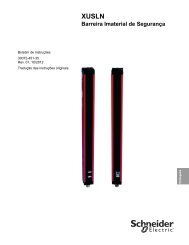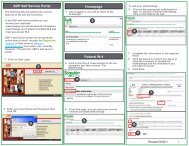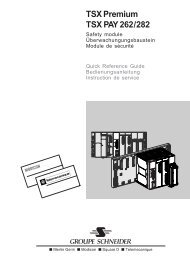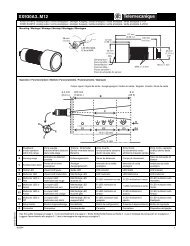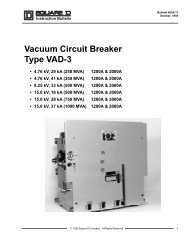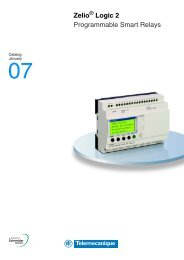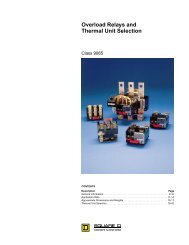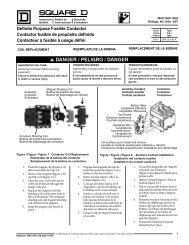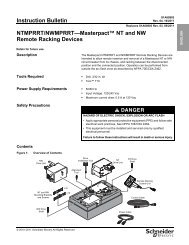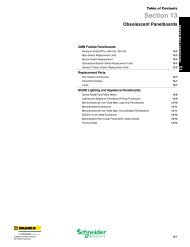Power-Style™ Switchboards Tableros de ... - Schneider Electric
Power-Style™ Switchboards Tableros de ... - Schneider Electric
Power-Style™ Switchboards Tableros de ... - Schneider Electric
You also want an ePaper? Increase the reach of your titles
YUMPU automatically turns print PDFs into web optimized ePapers that Google loves.
<strong>Power</strong>-Style <strong>Switchboards</strong><br />
Installing Cable Restraints for I-Line Main Lug Applications<br />
<strong>Tableros</strong> <strong>de</strong> distribución <strong>Power</strong>-Style tipo autosoportado<br />
Instalación <strong>de</strong> sujetadores <strong>de</strong> cable para las aplicaciones <strong>de</strong> zapatas<br />
principales I-Line<br />
Panneaux <strong>de</strong> commutation <strong>Power</strong>-Style MC<br />
Installation d’entraves <strong>de</strong> câbles pour les applications <strong>de</strong> cosses<br />
principales I-Line MC<br />
Instruction Bulletin<br />
Boletín <strong>de</strong> instrucciones<br />
Directives d'utilisation<br />
80236-202-01<br />
10/2012<br />
Retain for Future Use. /<br />
Conservar para uso futuro. /<br />
À conserver pour usage ultérieur.
Instruction Bulletin<br />
<strong>Power</strong>-Style <strong>Switchboards</strong><br />
Installing Cable Restraints for I-Line Main Lug Applications<br />
Class 2700<br />
Retain for future use.<br />
Table 1: Cable Restraint Criteria<br />
Supply<br />
Available Short Circuit<br />
Cable<br />
Fault Current (RMS)<br />
Current 65 65 85 100 125 > 125<br />
Rating (A) kA kA kA kA kA kA<br />
800 No Yes Yes Yes Yes Yes<br />
1200 No No No Yes Yes Yes<br />
1600 No No No No No Yes<br />
2000 No No No No No No<br />
2500 No No No No No No<br />
3000 No No No No No No<br />
Figure 1: Cable Restraint Example<br />
© 2012 Schnei<strong>de</strong>r <strong>Electric</strong> All Rights Reserved<br />
80236-202-01<br />
10/2012<br />
This bulletin shows how to add supply cable restraints for I-Line<br />
main lug applications in <strong>Power</strong>-Style switchboards manufactured by<br />
Schnei<strong>de</strong>r <strong>Electric</strong>. These restraints may be necessary to prevent cable<br />
movement un<strong>de</strong>r short-circuit conditions.<br />
NOTICE<br />
HAZARD OF CABLE MOVEMENT<br />
Install restraints to prevent the possible movement, un<strong>de</strong>r short-circuit<br />
conditions, of supply cables meeting the criteria listed in Table 1.<br />
Failure to follow this instruction can result in equipment damage.<br />
Refer to Table 1 to <strong>de</strong>termine if cable restraints are required. If restraints are<br />
required, perform the following steps.<br />
NOTE: Wrap supply cables using 1/2-inch (13 mm) diameter sisal rope or<br />
equivalent. Figure 1 shows an example of a completed cable restraint.<br />
1. Begin wrapping the cables a maximum distance of 11 in. (279 mm) from<br />
the end of the lugs (Figure 2). Continue to wrap the cables on 11-in.<br />
(279 mm) center(s) up to the point where the cables leave the enclosure.<br />
a. Wrap the cables four (4) times as shown, leaving 3 ft. (1 m) of<br />
excess rope at the first end (Figure 2, A).<br />
b. Pull the rope taut (Figure 2, B).<br />
Figure 2: Wrapping Cables<br />
Wrap 0.50 in<br />
(13 mm) sisal rope<br />
or equivalent<br />
Cables<br />
Lugs<br />
A<br />
2. Wrap the rope several times until the space between the cables is<br />
completely filled (Figure 3 on page 2).<br />
a. Weave the final rope loop un<strong>de</strong>rneath the previous loop (C).<br />
b. Bring the rope through the right-hand space.<br />
c. Pull the rope taut.<br />
B<br />
11.00 in<br />
(279 mm)<br />
End of<br />
lugs
<strong>Power</strong>-Style <strong>Switchboards</strong> 80236-202-01<br />
Instruction Bulletin 10/2012<br />
Schnei<strong>de</strong>r <strong>Electric</strong> USA, Inc.<br />
330 Weakley Road<br />
Smyrna, TN 37167 USA<br />
1-888-778-2733<br />
www.schnei<strong>de</strong>r-electric.us<br />
2<br />
Figure 3: Wrapping the Space Between Cables<br />
Left-hand space Right-hand space<br />
Cables<br />
Lugs<br />
3. Wrap the rope several times until the space between the cables is<br />
completely filled (Figure 4).<br />
a. Weave the final rope loop un<strong>de</strong>rneath the previous rope loop (D).<br />
b. Pull the rope taut.<br />
Figure 4: Finish Wrapping the Space Between Cables<br />
4. Tie the rope ends (1) and (2) together until they are taut (Figure 5). Cut<br />
off excess rope and tape ends to prevent fraying.<br />
Figure 5: Tying Rope Ends Together<br />
C<br />
Left-hand space Right-hand space<br />
Wrap rope<br />
Cables<br />
Lugs<br />
End 1<br />
End 1<br />
End 2<br />
5. After securing the cables, recheck the torque values of the wire-binding<br />
screws.<br />
NOTE: Refer to the torque label supplied with the switchboard for<br />
correct torque values.<br />
<strong>Electric</strong>al equipment should be installed, operated, serviced, and maintained only by<br />
qualified personnel. No responsibility is assumed by Schnei<strong>de</strong>r <strong>Electric</strong> for any<br />
consequences arising out of the use of this material.<br />
I-Line, <strong>Power</strong>-Style, Square D, and Schnei<strong>de</strong>r <strong>Electric</strong> are tra<strong>de</strong>marks or registered<br />
tra<strong>de</strong>marks of Schnei<strong>de</strong>r <strong>Electric</strong>. Other tra<strong>de</strong>marks used herein are the property of<br />
their respective owners.<br />
D<br />
End 2<br />
© 2012 Schnei<strong>de</strong>r <strong>Electric</strong> All Rights Reserved
Boletín <strong>de</strong> instrucciones<br />
80236-202-01<br />
10/2012<br />
<strong>Tableros</strong> <strong>de</strong> distribución <strong>Power</strong>-Style tipo autosoportado<br />
Instalación <strong>de</strong> sujetadores <strong>de</strong> cable para las aplicaciones <strong>de</strong> zapatas<br />
principales I-Line<br />
Clase 2700<br />
Conservar para uso futuro.<br />
Tabla 1: Criterios para el uso <strong>de</strong><br />
sujetadores <strong>de</strong> cable<br />
Corriente<br />
nominal <strong>de</strong>l<br />
cable <strong>de</strong><br />
alimentación<br />
(A)<br />
Corriente <strong>de</strong> falla <strong>de</strong> cortocircuito<br />
disponible (RMS)<br />
65<br />
kA<br />
65<br />
kA<br />
85<br />
kA<br />
100<br />
kA<br />
125<br />
kA<br />
> 125<br />
kA<br />
800 No Sí Sí Sí Sí Sí<br />
1 200 No No No Sí Sí Sí<br />
1 600 No No No No No Sí<br />
2 000 No No No No No No<br />
2 500 No No No No No No<br />
3 000 No No No No No No<br />
Figura 1: Ejemplo <strong>de</strong> sujetador <strong>de</strong> cable<br />
© 2012 Schnei<strong>de</strong>r <strong>Electric</strong> Reservados todos los <strong>de</strong>rechos<br />
Este boletín muestra cómo agregar sujetadores <strong>de</strong> cable <strong>de</strong> alimentación<br />
para aplicaciones <strong>de</strong> zapatas principales I-Line en tableros <strong>de</strong><br />
distribución <strong>Power</strong>-Style tipo autosoportado fabricados por Schnei<strong>de</strong>r<br />
<strong>Electric</strong>. Estos sujetadores pue<strong>de</strong>n ser necesarios para evitar el movimiento<br />
<strong>de</strong>l cable bajo condiciones <strong>de</strong> cortocircuito.<br />
AVISO<br />
PELIGRO DE MOVIMIENTO DEL CABLE<br />
Instale sujetadores para evitar el posible movimiento, bajo condiciones <strong>de</strong><br />
cortocircuito, <strong>de</strong> los cables <strong>de</strong> alimentación que cumplen con los criterios<br />
enumerados en la tabla 1.<br />
El incumplimiento <strong>de</strong> esta instrucción pue<strong>de</strong> causar daño al equipo.<br />
Consulte la tabla 1 para <strong>de</strong>terminar si necesita los sujetadores <strong>de</strong> cable. Si<br />
se necesitan los sujetadores, realice los siguientes pasos.<br />
NOTA: Enre<strong>de</strong> los cables <strong>de</strong> la alimentación con una cuerda <strong>de</strong> sisal<br />
<strong>de</strong> 13 mm (1/2 pulg) <strong>de</strong> diámetro o una equivalente. La figura 1 muestra un<br />
ejemplo <strong>de</strong> un sujetador <strong>de</strong> cable terminado.<br />
1. Comience a enredar los cables a una distancia <strong>de</strong> no más <strong>de</strong> 279 mm<br />
(11 pulg) <strong>de</strong>s<strong>de</strong> el extremo <strong>de</strong> las zapatas (figura 2). Continúe enredando<br />
los cables centrados a la misma distancia, 279 mm (11 pulg), hasta el<br />
punto don<strong>de</strong> los cables salen <strong>de</strong>l gabinete.<br />
a. Enre<strong>de</strong> los cables cuatro (4) veces, como se muestra, <strong>de</strong>jando 1 m<br />
(3 pies) <strong>de</strong> cuerda en el primer extremo (figura 2, A).<br />
b. Jale la cuerda hasta tensarla (figura 2, B).<br />
Figura 2: Cómo enredar los cables<br />
Enre<strong>de</strong> cuerda <strong>de</strong> sisal<br />
<strong>de</strong> 13 mm (0,5 pulg) o<br />
una equivalente<br />
Cables<br />
Zapatas<br />
A<br />
2. Enre<strong>de</strong> la cuerda varias veces hasta llenar completamente el espacio<br />
entre los cables (figura 3 en la página 2).<br />
a. Entrelace el bucle final <strong>de</strong> la cuerda por <strong>de</strong>bajo <strong>de</strong>l bucle anterior (C).<br />
b. Pase la cuerda por el espacio <strong>de</strong>l lado <strong>de</strong>recho.<br />
c. Jale la cuerda hasta tensarla.<br />
B<br />
279 mm<br />
(11 pulg)<br />
Extremo <strong>de</strong><br />
zapatas
<strong>Tableros</strong> <strong>de</strong> distribución <strong>Power</strong>-Style tipo autosoportado 80236-202-01<br />
Boletín <strong>de</strong> instrucciones 10/2012<br />
Figura 5: Cómo amarrar los extremos <strong>de</strong> la<br />
cuerda<br />
Extremo 1<br />
Importado en México por:<br />
Schnei<strong>de</strong>r <strong>Electric</strong> USA, Inc.<br />
Calz. J. Rojo Gómez 1121-A<br />
Col. Gpe. <strong>de</strong>l Moral 09300 México, D.F.<br />
Tel. 55-5804-5000<br />
www.schnei<strong>de</strong>r-electric.com.mx<br />
Extremo 2<br />
Figura 3: Cómo enredar la cuerda en el espacio entre los cables<br />
Espacio <strong>de</strong>l lado<br />
izquierdo<br />
Zapatas<br />
3. Enre<strong>de</strong> la cuerda varias veces hasta llenar completamente el espacio<br />
entre los cables (figura 4).<br />
a. Entrelace el bucle final <strong>de</strong> la cuerda por <strong>de</strong>bajo <strong>de</strong>l bucle anterior (D)<br />
<strong>de</strong> la cuerda.<br />
b. Jale la cuerda hasta tensarla.<br />
Figura 4: Cómo terminar <strong>de</strong> enredar la cuerda en el espacio entre<br />
los cables<br />
4. Amarre los extremos (1) y (2) <strong>de</strong> la cuerda hasta tensarlos (figura 5).<br />
Corte el exceso <strong>de</strong> cuerda y ponga cinta <strong>de</strong> aislar en las puntas para<br />
evitar que se <strong>de</strong>shilache.<br />
5. Después <strong>de</strong> asegurar los cables, vuelva a comprobar los valores <strong>de</strong> par<br />
<strong>de</strong> apriete <strong>de</strong> los tornillos <strong>de</strong> sujeción <strong>de</strong> cables.<br />
NOTA: Consulte la etiqueta incluida con el tablero <strong>de</strong> distribución para<br />
obtener los valores correctos <strong>de</strong> par <strong>de</strong> apriete.<br />
Solamente el personal especializado <strong>de</strong>berá instalar, hacer funcionar y prestar<br />
servicios <strong>de</strong> mantenimiento al equipo eléctrico. Schnei<strong>de</strong>r <strong>Electric</strong> no asume<br />
responsabilidad alguna por las consecuencias emergentes <strong>de</strong> la utilización <strong>de</strong> este<br />
material.<br />
I-Line, <strong>Power</strong>-Style, Square D y Schnei<strong>de</strong>r <strong>Electric</strong> son marcas comerciales o marcas<br />
registradas <strong>de</strong> Schnei<strong>de</strong>r <strong>Electric</strong>. Cualquier otra marca comercial utilizada en este<br />
documento pertenece a sus respectivos propietarios.<br />
2 © 2012 Schnei<strong>de</strong>r <strong>Electric</strong> Reservados todos los <strong>de</strong>rechos<br />
Cables<br />
Espacio <strong>de</strong>l lado<br />
izquierdo<br />
Enre<strong>de</strong> la<br />
cuerda<br />
Cables<br />
Zapatas<br />
C<br />
D<br />
Extremo 1<br />
Espacio <strong>de</strong>l lado<br />
<strong>de</strong>recho<br />
Espacio <strong>de</strong>l lado<br />
<strong>de</strong>recho<br />
Extremo 2
Directives d’utilisation<br />
80236-202-01<br />
10/2012<br />
Panneaux <strong>de</strong> commutation <strong>Power</strong>-Style MC<br />
Installation d’entraves <strong>de</strong> câbles pour les applications <strong>de</strong> cosses principales<br />
I-Line MC<br />
Classe 2700<br />
À conserver pour usage ultérieur.<br />
Tableau 1 : Critères <strong>de</strong> l'entrave <strong>de</strong> câble<br />
Courant<br />
nominal<br />
du câble<br />
d'aliment.<br />
(A)<br />
Courant <strong>de</strong> défaut <strong>de</strong> court-circuit<br />
disponible (RMS)<br />
65<br />
kA<br />
65<br />
kA<br />
85<br />
kA<br />
100<br />
kA<br />
125<br />
kA<br />
© 2012 Schnei<strong>de</strong>r <strong>Electric</strong> Tous droits réservés<br />
> 125<br />
kA<br />
800 Non Oui Oui Oui Oui Oui<br />
1200 Non Non Non Oui Oui Oui<br />
1600 Non Non Non Non Non Oui<br />
2000 Non Non Non Non Non Non<br />
2500 Non Non Non Non Non Non<br />
3000 Non Non Non Non Non Non<br />
Figure 1 : Exemple d'entrave <strong>de</strong> câbles<br />
Ces directives d'utilisation expliquent comment ajouter <strong>de</strong>s entraves <strong>de</strong><br />
câbles d'alimentation pour les applications <strong>de</strong> cosses principales I-Line MC<br />
dans <strong>de</strong>s panneaux <strong>de</strong> commutation <strong>Power</strong>-Style MC fabriqués par<br />
Schnei<strong>de</strong>r <strong>Electric</strong>. Ces entraves peuvent être nécessaires pour éviter tout<br />
déplacement <strong>de</strong> câbles dans <strong>de</strong>s conditions <strong>de</strong> court-circuit.<br />
AVIS<br />
RISQUE DE DÉPLACEMENT DE CÂBLES<br />
Installez <strong>de</strong>s entraves pour éviter le déplacement possible, dans <strong>de</strong>s<br />
conditions <strong>de</strong> court-circuit, <strong>de</strong> câbles d'alimentation, répondant aux<br />
critères indiqués dans le tableau 1.<br />
Si cette directive n'est pas respectée, cela peut entraîner <strong>de</strong>s<br />
dommages matériels.<br />
Voir le tableau 1 pour déterminer si <strong>de</strong>s entraves <strong>de</strong> câbles sont<br />
nécessaires. Dans l'affirmative, effectuer les points suivants.<br />
REMARQUE : Entourer les câbles d'alimentation d'une cor<strong>de</strong> en sisal<br />
<strong>de</strong> 13 mm (1/2 po) <strong>de</strong> diamètre ou l'équivalent. La figure 1 donne un<br />
exemple d'entrave <strong>de</strong> câbles terminée.<br />
1. Commencer à entourer les câbles à une distance maximale <strong>de</strong> 279 mm<br />
(11 po) <strong>de</strong> l'extrémité <strong>de</strong>s cosses (figure 2). Continuer à entourer les<br />
câbles centrés à cette distance, 279 mm (11 po), jusqu'au point où les<br />
câbles sortent du coffret.<br />
a. Entourer les câbles quatre (4) fois comme illustré, en laissant 1 m<br />
(3 pi) d'excès <strong>de</strong> cor<strong>de</strong> à la première extrémité (figure 2, A).<br />
b. Tirer sur la cor<strong>de</strong> et bien la tendre (figure 2, B).<br />
Figure 2 : Entourage <strong>de</strong>s câbles<br />
Entourer <strong>de</strong> cor<strong>de</strong> en<br />
sisal <strong>de</strong> 13 mm (1/2 po)<br />
ou l'équivalent<br />
Câbles<br />
Cosses<br />
A<br />
2. Faire plusieurs tours avec la cor<strong>de</strong> jusqu'à ce qu'elle remplisse<br />
complètement l'espace entre les câbles (figure 3 à la page 2).<br />
a. Faire passer la <strong>de</strong>rnière boucle <strong>de</strong> la cor<strong>de</strong> sous la boucle<br />
précé<strong>de</strong>nte (C).<br />
b. Engager la cor<strong>de</strong> dans l'espace <strong>de</strong> droite.<br />
c. Tirer sur la cor<strong>de</strong> et bien la tendre.<br />
B<br />
279 mm<br />
(11 po)<br />
Extrémité <strong>de</strong>s cosses
Panneaux <strong>de</strong> commutation <strong>Power</strong>-Style MC 80236-202-01<br />
Directives d’utilisation 10/2012<br />
Figure 5 : Attacher ensemble les<br />
extrémités <strong>de</strong> la cor<strong>de</strong><br />
Extrémité 1<br />
Schnei<strong>de</strong>r <strong>Electric</strong> Canada, Inc.<br />
5985 McLaughlin Road<br />
Mississauga, ON L5R 1B8 Canada<br />
Tel:1-800-565-6699<br />
www.schnei<strong>de</strong>r-electric.ca<br />
Extrémité 2<br />
Figure 3 : Entourage <strong>de</strong> l'espace entre les câbles<br />
Espace <strong>de</strong> gauche Espace <strong>de</strong> droite<br />
Cosses<br />
3. Faire plusieurs tours avec la cor<strong>de</strong> jusqu'à ce qu'elle remplisse<br />
complètement l'espace entre les câbles (figure 4).<br />
a. Faire passer la <strong>de</strong>rnière boucle <strong>de</strong> la cor<strong>de</strong> sous la boucle<br />
précé<strong>de</strong>nte (D).<br />
b. Tirer sur la cor<strong>de</strong> et bien la tendre.<br />
Figure 4 : Finition <strong>de</strong> l'entourage <strong>de</strong> cor<strong>de</strong> dans l'espace entre les<br />
câbles<br />
4. Attacher ensemble les extrémités (1) et (2) jusqu'à ce qu'elles soient<br />
tendues (figure 5). Couper l'excès <strong>de</strong> cor<strong>de</strong> et fixer les extrémités avec<br />
un ruban adhésif pour les empêcher <strong>de</strong> s'effilocher.<br />
5. Après avoir sécurisé les câbles, vérifier <strong>de</strong> nouveau les valeurs <strong>de</strong><br />
couple <strong>de</strong> serrage <strong>de</strong>s vis <strong>de</strong> fixation <strong>de</strong>s fils.<br />
REMARQUE : Se reporter à l'étiquette <strong>de</strong>s couples fournie avec le<br />
panneau <strong>de</strong> commutation pour trouver les valeurs <strong>de</strong> couple correctes.<br />
Seul un personnel qualifié doit effectuer l’installation, l’utilisation, l’entretien et la<br />
maintenance du matériel électrique. Schnei<strong>de</strong>r <strong>Electric</strong> n’assume aucune<br />
responsabilité <strong>de</strong>s conséquences éventuelles découlant <strong>de</strong> l’utilisation <strong>de</strong> cette<br />
documentation.<br />
I-Line, <strong>Power</strong>-Style, Square D et Schnei<strong>de</strong>r <strong>Electric</strong> sont marques commerciales ou<br />
marques déposées <strong>de</strong> Schnei<strong>de</strong>r <strong>Electric</strong>. Toutes autres marques commerciales<br />
utilisées dans ce document sont la propriété <strong>de</strong> leurs propriétaires respectifs.<br />
2 © 2012 Schnei<strong>de</strong>r <strong>Electric</strong> Tous droits réservés<br />
Câbles<br />
C<br />
Espace <strong>de</strong> gauche Espace <strong>de</strong> droite<br />
Entourer le<br />
cor<strong>de</strong><br />
Câbles<br />
Cosses<br />
D<br />
Extrémité 1<br />
Extrémité 2
<strong>Power</strong>-Style <strong>Switchboards</strong>—Installing Cable Restraints for I-Line Main Lug Applications<br />
<strong>Tableros</strong> <strong>de</strong> distribución <strong>Power</strong>-Style tipo autosoportado—Instalación <strong>de</strong> sujetadores <strong>de</strong> cable para las aplicaciones <strong>de</strong> zapatas<br />
principales I-Line<br />
Panneaux <strong>de</strong> commutation <strong>Power</strong>-Style MC —Installation d’entraves <strong>de</strong> câbles pour les applications <strong>de</strong> cosses principales I-Line MC<br />
<strong>Electric</strong>al equipment should be installed,<br />
operated, serviced, and maintained only by<br />
qualified personnel. No responsibility is assumed<br />
by Schnei<strong>de</strong>r <strong>Electric</strong> for any consequences<br />
arising out of the use of this material.<br />
I-Line, <strong>Power</strong>-Style, Square D, and<br />
Schnei<strong>de</strong>r <strong>Electric</strong> are tra<strong>de</strong>marks or registered<br />
tra<strong>de</strong>marks of Schnei<strong>de</strong>r <strong>Electric</strong>. Other<br />
tra<strong>de</strong>marks used herein are the property of their<br />
respective owners.<br />
Schnei<strong>de</strong>r <strong>Electric</strong> USA, Inc.<br />
330 Weakley Road<br />
Smyrna, TN 37167 USA<br />
1-888-778-2733<br />
www.schnei<strong>de</strong>r-electric.us<br />
80236-202-01 10/2012<br />
© 2012 Schnei<strong>de</strong>r <strong>Electric</strong><br />
All Rights Reserved<br />
Solamente el personal especializado <strong>de</strong>berá instalar,<br />
hacer funcionar y prestar servicios <strong>de</strong> mantenimiento<br />
al equipo eléctrico. Schnei<strong>de</strong>r <strong>Electric</strong> no asume<br />
responsabilidad alguna por las consecuencias<br />
emergentes <strong>de</strong> la utilización <strong>de</strong> este material.<br />
I-Line, <strong>Power</strong>-Style, Square D y Schnei<strong>de</strong>r <strong>Electric</strong><br />
son marcas comerciales o marcas registradas <strong>de</strong><br />
Schnei<strong>de</strong>r <strong>Electric</strong>. Cualquier otra marca comercial<br />
utilizada en este documento pertenece a sus<br />
respectivos propietarios.<br />
Importado en México por:<br />
Schnei<strong>de</strong>r <strong>Electric</strong> México, S.A. <strong>de</strong> C.V.<br />
Calz. J. Rojo Gómez 1121-A<br />
Col. Gpe. <strong>de</strong>l Moral 09300 México, D.F.<br />
Tel. 55-5804-5000<br />
www.schnei<strong>de</strong>r-electric.com.mx<br />
80236-202-01 10/2012<br />
© 2012 Schnei<strong>de</strong>r <strong>Electric</strong><br />
Reservados todos los <strong>de</strong>rechos<br />
Seul un personnel qualifié doit effectuer l’installation,<br />
l’utilisation, l’entretien et la maintenance du matériel<br />
électrique. Schnei<strong>de</strong>r <strong>Electric</strong> n’assume aucune<br />
responsabilité <strong>de</strong>s conséquences éventuelles<br />
découlant <strong>de</strong> l’utilisation <strong>de</strong> cette documentation.<br />
I-Line, <strong>Power</strong>-Style, Square D et Schnei<strong>de</strong>r <strong>Electric</strong><br />
sont marques commerciales ou marques déposées <strong>de</strong><br />
Schnei<strong>de</strong>r <strong>Electric</strong>. Toutes autres marques<br />
commerciales utilisées dans ce document sont la<br />
propriété <strong>de</strong> leurs propriétaires respectifs.<br />
Schnei<strong>de</strong>r <strong>Electric</strong> Canada, Inc.<br />
5985 McLaughlin Road<br />
Mississauga, ON L5R 1B8 Canada<br />
Tel:1-800-565-6699<br />
www.schnei<strong>de</strong>r-electric.ca<br />
80236-202-01 10/2012<br />
© 2012 Schnei<strong>de</strong>r <strong>Electric</strong><br />
Tous droits réservés



